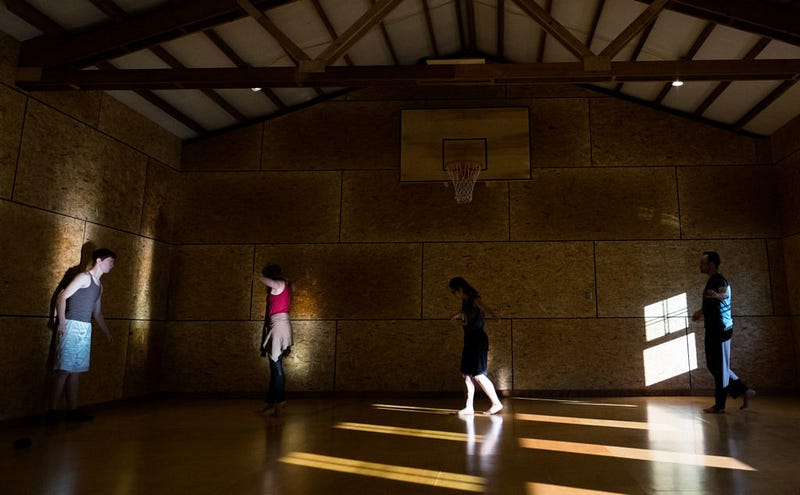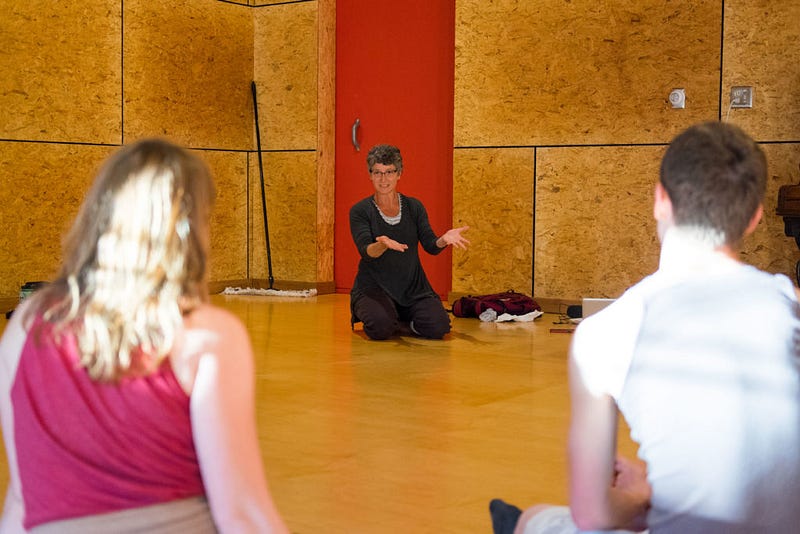Inspiration through dance
Pam Knutz is the founder of Kuntz and Company and she uses her Bellingham-based group to perform arts as a means of understanding life
STORY BY ANNA GOAD | PHOTOS BY JAKE TULL
(Above) Dancers walk down an imaginary tightrope and start to fall to demonstrate the unsteadiness of life, in an attempt to find dance moves that fit that concept.
“I really like this tightrope idea. It’s intense, but the imagery is strong.” Pam Kuntz sits on the floor of her sunny dance studio, legs outstretched, toes perfectly pointed. She is studying a large piece of construction paper that has been written on with a purple Sharpie. The paper is filled with the thoughts of students from Kulshan Middle School where Pam interviewed a class to ask what they knew about isolation. One sixth-grader described isolation like tight rope that everyone walks on. Some people fall off and never get back on.
Pam, a professor in Western’s Theater and Dance Department, is waiting for her dancers to arrive. Pam chose Cara, Yuki, Ian and Evan for this specific piece, which will tentatively centralize around the symptoms of bullying among adolescents and teens. This is the first rehearsal for the performance and Pam isn’t sure what direction to take it. As the dancers stretch, roll on their backs and easily contorting their limbs into impressive angles, Pam fills them in on the topic. There seems to be some confusion on both sides over her hazy vision. “We’ll figure it out as we go. You know how I work,” Pam says with a smile. The students laugh together because, yes, they know how she works.
To Pam, the performing arts are not a means of escape from life, but an apparatus to better understand it. Pam founded Kuntz and Company, a Bellingham-based performance group that uses dance, theater and media to tell the stories of members of the community. Pam perceives characteristics that are traditionally scrutinized by society as valid and she uses her performers to work towards promoting a deeper understanding of what it means to be human.

Pam interviews people who have insight to universal struggles, such as the care and neglect of children, religion, aging and “disabilities”. The word disabilities is perpetually in air quotes for Pam, who believes that we’re all disabled in some way. Pam’s students have no limits. She teaches students who are dancing for the first time at their 80th birthday, a man with Parkinson’s and a few dancers with Autism.
It is evident that the studio is a powerful place of inspiration. Pam guides her dancers, instructing them to navigate their way over an imaginary tightrope. She leans forward, eyes glued to the movement unfolding before her. After a few moments, Pam asks the dancers what comes to mind when they think of isolation. Someone suggests the idea of pressure and conforming to others’ expectations.
As a result, Yuki, 23-year-old and barely five feet tall, is squeezed and pushed into an arrangement by Ian and Evan. Queen’s song, “Under Pressure” plays in the background as Ian and Evan adjust Yuki, squeezing her shoulders together with their own bodies, slowly collapsing the strength of her legs so she folds over, arms tangled in front of her.
“Stop,” Pam says, cutting the music on her MacBook. Yuki is left contorted as the men walk away. It’s grotesque and riveting at the same time and everyone feels it, especially Pam, who claps loudly. “We have a real gem here!” Pam says, her voice echoing thorough the studio.

Before rehearsal comes to an end Pam and the dancers sit in a semi circle on the wooden floor, reflecting on what experiences they’ve had with isolation and bullying. Pam does very little talking, allowing her dancers room to talk about their pasts — how cyberbullying affected high school for Ian and Cara, and whether school was different in Japan for Yuki.
In that moment, it’s clear that Pam is a medium for the stories around her. She translates the personal tales of others, good and bad, heartbreaking and triumphant, and turns them into living pieces of art. Each detail is taken into consideration. Without altering them, she transforms each sentence she hears into a step, a twirl or a leap. The stories Pam hears are not hers, but when she translates them into art they become a collective experience that anyone can see and understand. After all, that’s the point of art — to bring people out of isolation.
